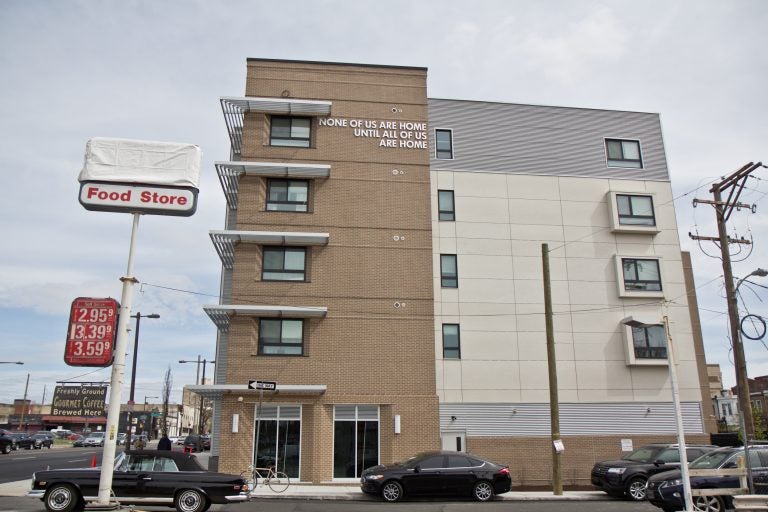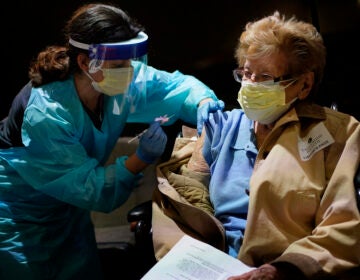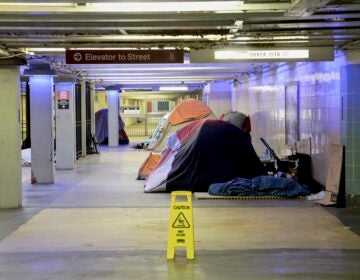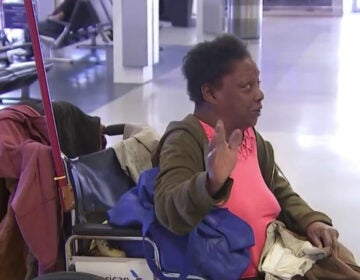Philly’s homeless shelters prepare for unique challenge coronavirus brings
A lot of cleaning and monitoring for symptoms is going on since close quarters would make it hard for residents to keep a distance from an ill individual.

The Ruth Williams House at Broad and Boston Streets in Philadelphia has 88 units for those in need of affordable housing. (Kimberly Paynter/WHYY)
Philadelphia’s homeless and emergency shelters have a unique risk from the coronavirus. The close quarters make it hard for residents to keep distance between them and a potentially infected person.
Since cases of COVID-19, the illness caused by the virus, have been reported in more than a dozen states, containment is not a likely outcome here. The city’s Department of Public Health is aiming to slow the virus’s spread, according to spokesperson James Garrow. The slower the virus spreads, the fewer patients the city’s health care systems will have to treat at any one time.
Project HOME, which manages a number of residences across the city, is taking most of its cues from the Centers for Disease Control and Prevention and the Health Department, said Monica Medina McCurdy, vice president for health care services.
To be cautious, however, Project HOME is going beyond CDC guidelines, she said.
“CDC is recommending routine cleaning and not advising anything more than that, but our staff are doing extra cleaning, particularly around disinfecting services [for] frequent ‘high-touch’ areas like doorknobs, handrails, things like that,” McCurdy said.
In addition, Project Home’s facilities are actively monitoring people for the symptoms of COVID-19, which the CDC says have included mild to severe respiratory illness with fever, cough and difficulty breathing.
But since someone can have the virus without showing symptoms, it poses a difficult challenge for crowded spaces such as shelters.
To slow the spread, the city Health Department suggests implementing social distancing measures, but it’s reluctant to do so too soon, for fear of putting more pressure on an already under-resourced system.
“These places, trying to find a few square inches in them even just to breathe is difficult, and recommending that homeless shelters set up sick sections or find sheets to set up in between beds … they’re running on a shoestring budget a lot of them. It really becomes difficult,” Garrow said.
At the moment, shelters are following CDC protocol to determine areas at risk, but the relative lack of testing to date has McCurdy concerned.
“I think the positive screen is a little bit problematic because right now they’re saying a positive screen is international travel plus symptoms, but we now know there are cases in the United States where the person didn’t travel internationally,” she said. “It’s a difficult situation because there might be cases already in our community that we just don’t know about.”
The Health Department does not have a specific threshold for when shelters should implement distancing measures.
“As much as they don’t want disease to spread within homeless shelters, they also want people to be able to enter those shelters,” Garrow said. “It’s a delicate balancing act.”
Project HOME said it does not often see illness spread quickly in its residences, but more crowded centers do.
Jeff Deeney, a former case manager at the Urban Affairs Coalition’s Center for H.O.P.E. shelter, described observing how disease spreads within shelters.
“I would imagine it’s going to happen very quickly,” Deeney said. “I can tell you, when I was working in the shelter system, every year the flu hits, you would just watch it hop from room to room.”
To make matters worse, the coronavirus is especially damaging to the elderly, a population that Deeney has seen grow in the shelter system over time.
“The fact is, the shelter population today is older and much more frail than it ever has been,” Deeney said.
The nature of homelessness is such that self-quarantining is impossible. McCurdy described how in moments of public crisis, those without homes face the brunt of it worse than others.
“They experience so much of the downstream effects of things like this: huge public health issues that affect people with resources who have places to go and safe places to live, but those who are homeless or very low income are going to be impacted even worse by things like this,” McCurdy said.
The city Health Department has not yet provided shelters with guidelines for quarantining, McCurdy said, but she expects some guidance will be provided at various information sessions in the coming weeks.
Though Project HOME has a deep bench of substitute workers to call upon in case of staff shortages as a result of measures to prevent spread of the virus, the Health Department has broad concerns about how institutions around the city will manage.
“It’s something I don’t think homeless shelters large or small are ready to deal with and to be completely honest, I have questions about most of the businesses and nonprofits and city agencies along the same lines,” Garrow said.
The Health Department is currently working with with the Office of Homeless Services and nonprofits to take steps to prepare and mitigate risks, Garrow said.
 WHYY is one of over 20 news organizations producing Broke in Philly, a collaborative reporting project on solutions to poverty and the city’s push towards economic justice. Follow us at @BrokeInPhilly.
WHYY is one of over 20 news organizations producing Broke in Philly, a collaborative reporting project on solutions to poverty and the city’s push towards economic justice. Follow us at @BrokeInPhilly.
WHYY is your source for fact-based, in-depth journalism and information. As a nonprofit organization, we rely on financial support from readers like you. Please give today.




![CoronavirusPandemic_1024x512[1]](https://whyy.org/wp-content/uploads/2020/03/CoronavirusPandemic_1024x5121-300x150.jpg)


